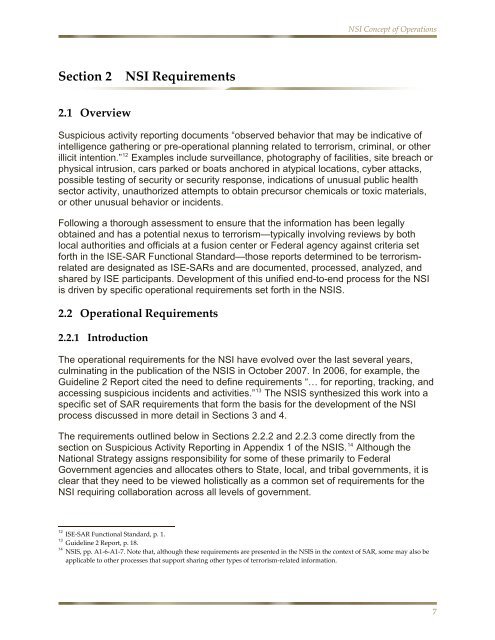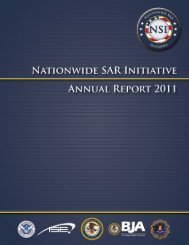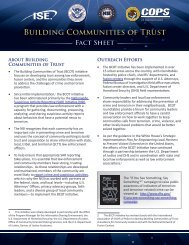NSI Concept of Operations Version 1, December 2008
NSI Concept of Operations Version 1, December 2008
NSI Concept of Operations Version 1, December 2008
Create successful ePaper yourself
Turn your PDF publications into a flip-book with our unique Google optimized e-Paper software.
<strong>NSI</strong> <strong>Concept</strong> <strong>of</strong> <strong>Operations</strong><br />
Section 2<br />
<strong>NSI</strong> Requirements<br />
2.1 Overview<br />
Suspicious activity reporting documents “observed behavior that may be indicative <strong>of</strong><br />
intelligence gathering or pre-operational planning related to terrorism, criminal, or other<br />
illicit intention.” 12 Examples include surveillance, photography <strong>of</strong> facilities, site breach or<br />
physical intrusion, cars parked or boats anchored in atypical locations, cyber attacks,<br />
possible testing <strong>of</strong> security or security response, indications <strong>of</strong> unusual public health<br />
sector activity, unauthorized attempts to obtain precursor chemicals or toxic materials,<br />
or other unusual behavior or incidents.<br />
Following a thorough assessment to ensure that the information has been legally<br />
obtained and has a potential nexus to terrorism—typically involving reviews by both<br />
local authorities and <strong>of</strong>ficials at a fusion center or Federal agency against criteria set<br />
forth in the ISE-SAR Functional Standard—those reports determined to be terrorismrelated<br />
are designated as ISE-SARs and are documented, processed, analyzed, and<br />
shared by ISE participants. Development <strong>of</strong> this unified end-to-end process for the <strong>NSI</strong><br />
is driven by specific operational requirements set forth in the <strong>NSI</strong>S.<br />
2.2 Operational Requirements<br />
2.2.1 Introduction<br />
The operational requirements for the <strong>NSI</strong> have evolved over the last several years,<br />
culminating in the publication <strong>of</strong> the <strong>NSI</strong>S in October 2007. In 2006, for example, the<br />
Guideline 2 Report cited the need to define requirements “… for reporting, tracking, and<br />
accessing suspicious incidents and activities.” 13 The <strong>NSI</strong>S synthesized this work into a<br />
specific set <strong>of</strong> SAR requirements that form the basis for the development <strong>of</strong> the <strong>NSI</strong><br />
process discussed in more detail in Sections 3 and 4.<br />
The requirements outlined below in Sections 2.2.2 and 2.2.3 come directly from the<br />
section on Suspicious Activity Reporting in Appendix 1 <strong>of</strong> the <strong>NSI</strong>S. 14 Although the<br />
National Strategy assigns responsibility for some <strong>of</strong> these primarily to Federal<br />
Government agencies and allocates others to State, local, and tribal governments, it is<br />
clear that they need to be viewed holistically as a common set <strong>of</strong> requirements for the<br />
<strong>NSI</strong> requiring collaboration across all levels <strong>of</strong> government.<br />
12<br />
ISE‐SAR Functional Standard, p. 1.<br />
13<br />
Guideline 2 Report, p. 18.<br />
14<br />
<strong>NSI</strong>S, pp. A1‐6‐A1‐7. Note that, although these requirements are presented in the <strong>NSI</strong>S in the context <strong>of</strong> SAR, some may also be<br />
applicable to other processes that support sharing other types <strong>of</strong> terrorism‐related information.<br />
7






